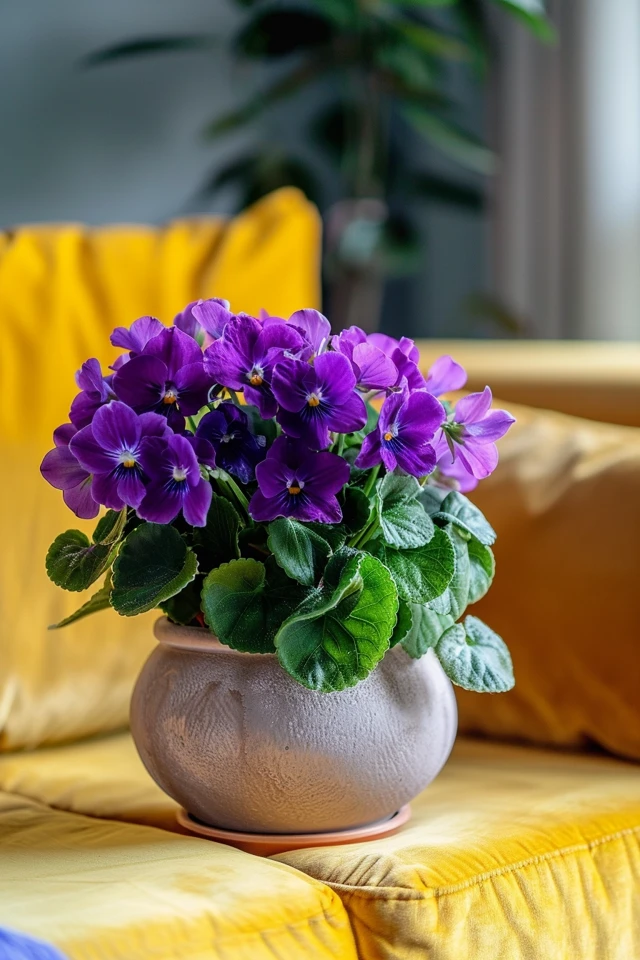Hello, fellow African Violet enthusiasts! If you’re looking for the best practices to care for your beloved African Violets, you’ve come to the right place. Today, I want to share with you some valuable watering tips specifically tailored to this delicate and stunning plant.
African Violets, renowned for their vibrant blooms and lush foliage, require gentle care, especially when it comes to watering. Whether you are a beginner or an experienced gardener, understanding the proper techniques for watering African Violets is crucial to their overall well-being.
When watering African Violets from the top, it is essential to use a long spout watering can. This allows you to delicately water the soil without wetting the foliage and crown, which can lead to diseases and damage. Additionally, ensure that the water is at room temperature to avoid shocking the plants.
Remember, excess water can be detrimental, so allow it to drain away after watering to prevent the accumulation of harmful salts in the soil. This simple watering routine will keep your African Violets happy and healthy, showcasing their vibrant colors for all to admire.
Key Takeaways:
- Gently watering African Violets from the top helps prevent foliage and crown damage.
- Use a long spout watering can and ensure the water is at room temperature.
- Drain excess water to avoid the buildup of harmful salts in the soil.
- Gentle care and proper watering techniques contribute to the overall health and beauty of African Violets.
- By implementing these best practices, you can enjoy stunning African Violet blooms for years to come.

Determining Watering Frequency for African Violets
When it comes to watering African Violets, there are several factors to consider in order to establish the optimal watering routine. By monitoring the soil moisture and adjusting watering practices accordingly, you can ensure the health and vitality of your African Violets.
To determine the watering frequency, begin by checking the moisture level of the soil. Gently touch the top of the soil with your fingers to assess its dryness. African Violets prefer to be watered when the soil feels dry to the touch, but not completely parched.
The size of the pot and the overall size of the plant also impact watering needs. Smaller pots tend to dry out faster, requiring more frequent watering, while larger pots retain moisture for longer periods of time.
Seasonal changes play a role in watering frequency as well. During summer months with higher evaporation rates, African Violets may need more frequent watering to compensate for the increased moisture loss. Conversely, in cooler months, when evaporation rates are lower, watering may need to be adjusted to prevent overwatering.
As African Violets enter their flowering period, it becomes even more crucial to closely monitor soil moisture levels. Proper watering techniques during this time will ensure the blooms are vibrant and long-lasting.
Monitoring soil moisture levels
To effectively monitor soil moisture, regularly assess humidity levels, room conditions, and environmental factors. Aside from physically checking the soil’s dryness, consider investing in a moisture meter to provide accurate readings. This tool can be useful for maintaining the proper watering schedule and preventing under or overwatering.
Tip: When it comes to watering African Violets, finding the right balance is key. Aim for soil that is consistently slightly moist but never waterlogged.
Watering techniques for flowering African Violets
During the flowering period, it’s important to employ watering techniques that support the growth and vibrancy of the blooms. One effective method is bottom watering, where the pot is placed in a saucer of water until the top of the soil is moistened. This technique helps avoid wetting the foliage and crown, which can lead to damage or disease.

Risks of Improper Watering and Promoting Optimal Growth
Proper watering is crucial for the health and beauty of African Violets. Failing to water African Violets correctly can have detrimental effects on their growth and overall well-being. Overwatering is a common mistake that can lead to root rot and ultimately result in the death of the plant. It is essential to allow the soil to dry out between watering sessions to prevent waterlogging and promote healthy root development.
On the other hand, underwatering can also pose risks to African Violets. Insufficient water supply can cause the foliage to wilt and hinder the plant’s growth. To prevent underwatering, it is important to regularly check the moisture level of the soil and water the plant when the top layer feels dry to the touch. Maintaining a consistent watering routine is key to ensuring optimal growth and preventing the negative impacts of underwatering.
In addition to proper watering, preventing pests and diseases is an essential aspect of African Violet care. Disinfecting pots, potting soil, and tools before using them with African Violets can help eliminate harmful pathogens and maintain a healthy growing environment. Good air circulation and keeping the growing area clean also play a significant role in preventing infestations and diseases.
To promote optimal growth and enhance the aesthetic value of African Violets, disbudding should be practiced. By removing the buds, nutrients can be redirected towards new roots and leaves, stimulating healthy growth. Supporting the delicate foliage with stakes or supports and maintaining a consistent grooming routine further ensures the optimal health and beauty of African Violets, making them a delightful addition to any indoor garden.


